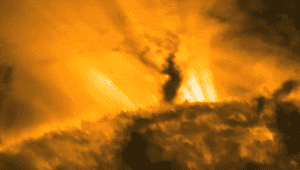Exactly two years ago, NASA launched a $850 million spacecraft, called the Solar Dynamics Observatory, on a five-year long mission to record high-definition videos of the sun, which should help astronomers better understand its weather cycle and how and how it might affect life on Earth. To celebrate SDO’s 2nd anniversary, NASA has released a stunning video featuring tornado-like formations swirling across the sun’s surface. Nothing short of amazing!

Sun tornadoes like the ones featured in the NASA video have been known to astronomers for decades now, and although they might look fairly similar to their counterparts on Earth, they’re very much different. Tornadoes on Earth need wind to be generated; wind which doesn’t exist on the sun. Instead of temperature of pressure fluctuations, powerful competing magnetic forces, which pull the charged magnetic particles on the sun back and forth, cause the erupting plasma to eject in a swirling manner.









